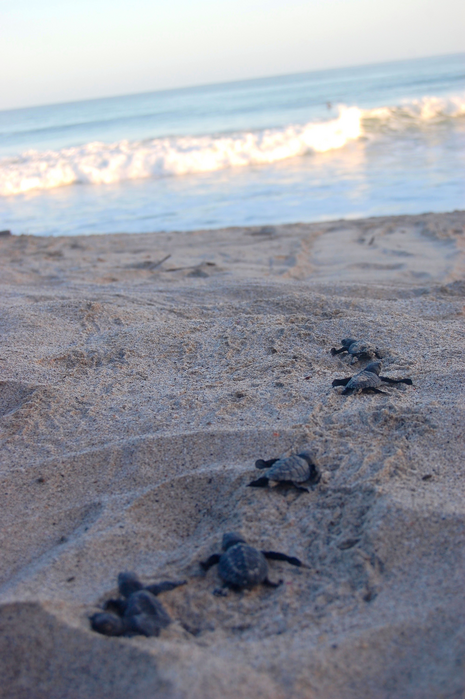Reviewed by Mila PereraOct 27 2022
A new inexpensive sensor engineered to look like a sea turtle egg allows researchers to observe nests remotely and predict when hatchlings will hatch nearly to the day, offering beneficial information for turtle nest management and conservation efforts.

With the help of the TurtleSense system, Olive Ridley hatchlings safely make their way to the ocean on the Pacific coast of Costa Rica. Image Credit: Erin Clabough, CC-BY 4.0 (https://creativecommons.org/licenses/by/4.0/)
Erin Clabough from the University of Virginia and Samuel Wantman from Nerds Without Borders directed the study, published in the October 26th, 2022, issue of the open-access journal PLOS ONE.
Globally, sea turtle populations are declining due to human activities, with Kemp’s Ridley, Green, Loggerhead, Leatherback, Hawksbill, and Olive Ridley sea turtles all listed as endangered species.
Sea turtle conservation efforts mainly concentrate on safeguarding vulnerable hatchlings once they come out of the nest to ensure that they make it to the sea rather than toward the bright lights of coastal areas. Conservationists can calculate the days since the eggs were laid to estimate when they will hatch and observe the nest, but these efforts are inaccurate and laborious.
In the current study, scientists used the TurtleSense system to study loggerhead sea turtle nests on Cape Hatteras National Seashore to see if they could predict more precisely when the turtles would appear from the nest. They concealed an egg-sized sensor within the nest and linked a cable to a communication tower that remotely conveyed data on hatchling movement inside the nest.
The scientists detected a pattern of strong hatchling movement inside the nest, followed by a hiatus, allowing them to estimate the exact day when the young turtles would emerge out of the sand.
Their findings suggest that hatchlings can sense motion, enabling them to communicate and emerge together as a group. The platform also correctly recognized non-viable nests where observation was no longer needed.
The new TurtleSense platform can potentially decrease the cost and labor needed to watch threatened turtle nests and help conservationists make better decisions concerning nest management. The platform can also reduce beach closures and allow communities to be involved in turtle-based ecotourism, helping the community and the sea turtle conservation efforts.
While this research concentrated on Loggerhead turtles, the scientists also watched Green Turtle and Olive Ridley nests and noticed similar patterns, signifying that the system will be appropriate for various sea turtle species.
It’s absolutely magical to witness baby turtles poke their heads out of the sand and sprint towards the ocean, but it’s an event that can be very hard to predict. The TurtleSense system is a low-cost, creative solution that remotely allows us to detect how baby turtles synchronize developmental movement within the nest in real time.
Erin Clabough, Study Lead Author, University of Virginia
“We can use the system to detect hatching and to better predict when the hatchlings will emerge onto the beach,” Erin Clabough added.
As each turtle emerges from its shell, it climbs up to join its siblings at the top of the clutch of eggs, creating a wave of commotion among all the other baby turtles in the nest. When there is no more commotion there is a period of quiet, which may be the impetus for all the hatchlings to boil out of the nest together.
Samuel Wantman, Study Lead Author, Nerds Without Borders
This study was supported by donations, volunteer work, and agreements between the Hatteras Island Ocean Center nonprofit and the National Park Service.
This study was also supported by the Virginia Foundation for Independent Colleges in the form of a grant awarded to EC, and the Hampden-Sydney Honors Program in the form of a grant awarded to JC.
Journal Reference
Clabough, E. B. D., et al. (2022) The secret life of baby turtles: A novel system to predict hatchling emergence, detect infertile nests, and remotely monitor sea turtle nest events. PLoS ONE. doi.org/10.1371/journal.pone.0275088.